
During hurricane season, homes are critically vulnerable to flooding. Residents can keep their homes and families safer with the use of innovative plastic products that reduce the risk of flooding and mudslides during extreme weather events and contribute to vital emergency kits and first responders’ ability to respond quickly and effectively.
Extreme weather, be it hurricanes, tornados, earthquakes, or fires, are scary but preparedness can help reduce the risk of injury and damage. Thin plastic sheeting, made from polyethylene, serves a number of purposes that reduces the impact of storms and fire.
In the event of heavy rains, plastic sheeting can redirect major water flows thereby decreasing runoff in soil which can sometimes cause severe mudslides. The Federal Emergency Management Agency (FEMA) recommends using sheeting to create a protective layer between high waters and buildings to reduce flooding in high risk areas. Plastic sheeting can also be used to preserve air quality if storms cause increased particles in the air. Fires and earthquakes, for example, can spread ash and particles from collapsed buildings that are harmful to lungs and health. Thin plastic layers over windows and vents can help create a barrier between those particles and your family.
When emergency crews set up temporary relief shelters for individuals who have been evacuated or face property damage due to an extreme weather event, they turn to the durability and sterility of plastic sheeting. Temporary shelters made out of plastic create secure locations for displaced individuals to remain until it is safe to return to their homes. For those sheltering in place, plastic sheeting can also provide an affordable way to build a temporary rain-proof shelter until the storm has passed. And this is just the start of how vital plastics are during extreme weather.
In addition to the versatility of plastic sheeting, plastics provide the vital elements needed in emergency kits. According to FEMA, all families should have a prepared disaster kit ready in the event of an emergency. As it happens, disaster preparedness kits rely on plastics to keep us safe. Disaster kits can include water kept sterile in durable plastic bottles, food kept fresh in sustainable plastic packaging, and medicine and first aid items like band aids and ice packs kept dry in plastic containers and packets. These products are all vital in the event of an emergency and can keep us and our families safe. The American Red Cross recommends that safety kits should also hold flashlights and extra batteries, more products that rely on plastic to make them affordable and durable for all during frightening times.
During natural disaster emergencies, many communities lose access to potable water, making dire situations even scarier. Bottled water is incredibly important to rescue efforts and sustains those sheltering in place until help arrives. When disaster strikes, plastics literally provide lifelines to millions of Americans each year.
While plastic is vital to natural disaster preparedness and relief, the plastics industry has also taken action to repurpose these discarded water bottles to avoid plastic waste. One innovative project repurposes used water bottles for structural components, including roofing, walls and columns, to create new disaster shelters. Efforts like this ensure that citizens are safe from natural disasters, while also protecting the environment.
Plastics provide a first line of defense for residents, both in plastic sheeting for water proofing and the products inside emergency kits, and for first responders who are standing by to lend a helping hand in the event of a disaster. First responders, those who are first on the scene in the event of an emergency, include paramedics, firefighters, rescue, police officers, and Emergency Medical Technicians (EMTs). Plastics support these courageous individuals every day.
When they arrive on scene, EMTs or paramedics must quickly get to those who may be injured. Their emergency kitshouse personal protective gear (PPE), including plastic gloves and masks, to keep both responder and the injured safe. Lightweight plastic breathing equipment, trauma sheers, blood pressure cuffs, and stethoscopes enable these first responders to quickly maneuver through difficult terrain and damaged buildings to reach those who need help.
As hurricane and fire season are upon us, it is important to build your own disaster response kit, with vital items that are made affordable and lightweight with the use of plastics. The same plastic products that help residents protect themselves also protect first responders to work efficiently and effectively in the event of an emergency.